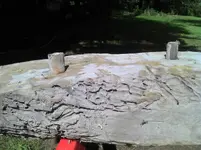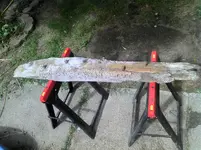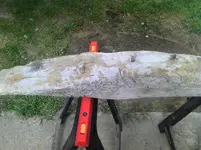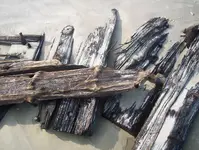You are using an out of date browser. It may not display this or other websites correctly.
You should upgrade or use an alternative browser.
You should upgrade or use an alternative browser.
Wooden Peg Question
- Thread starter old man
- Start date
Southern_Digger
Hero Member
Cannot assist you with that answer, however, consider this caulking procedure.... Once a spike is set in a hull, it can be sunk into the wood by using an iron pin. After which, a wooden plug is hammered atop it, thereby sealing the countersunk spike. The plug, or peg, is chiseled flush then sealant and/or copper covers that. If you found such, check it with a detector to determine if a spike is set below the peg.
aquanut
Bronze Member
- Joined
- Jul 12, 2005
- Messages
- 2,162
- Reaction score
- 1,579
- Golden Thread
- 0
- Location
- Sebastian, Florida
- Detector(s) used
- Fisher CZ21, Tesoro Tiger Shark
Cannot assist you with that answer, however, consider this caulking procedure.... Once a spike is set in a hull, it can be sunk into the wood by using an iron pin. After which, a wooden plug is hammered atop it, thereby sealing the countersunk spike. The plug, or peg, is chiseled flush then sealant and/or copper covers that. If you found such, check it with a detector to determine if a spike is set below the peg.
Good advice.
Jolly Mon
Hero Member
- Joined
- Sep 3, 2012
- Messages
- 868
- Reaction score
- 631
- Golden Thread
- 0
- Primary Interest:
- All Treasure Hunting
I am not an archaeologist or a shipwright, but I do know that treenails were definitely used in some areas of ship construction until well into the 19th century. Even some traditionally built 20th century vessels can have them. I think to be helpful in terms of dating, much depends on what hull components are being fastened by them.
old man
Bronze Member
- #5
Thread Owner
Ok Guys, I checked it with a Metal Detector. NO Metal in the Wood. Any other Ideas.Cannot assist you with that answer, however, consider this caulking procedure.... Once a spike is set in a hull, it can be sunk into the wood by using an iron pin. After which, a wooden plug is hammered atop it, thereby sealing the countersunk spike. The plug, or peg, is chiseled flush then sealant and/or copper covers that. If you found such, check it with a detector to determine if a spike is set below the peg.
Attachments
Jolly Mon
Hero Member
- Joined
- Sep 3, 2012
- Messages
- 868
- Reaction score
- 631
- Golden Thread
- 0
- Primary Interest:
- All Treasure Hunting
Once again, I am not an expert, but my understanding is that treenails, in and of themselves, are not really useful in determining the age of a vessel. A more comprehensive look at the details of construction is necessary. I am at a disadvantage because I am viewing on a mobile device, but it almost looks like some spar varnish is still visible near the center of the piece.
trsrseeker
Full Member
My understanding is they are still used today in some parts of the world for the same reason they were used in past centuries - cost and convenience.
FISHEYE
Bronze Member
- Joined
- Feb 27, 2004
- Messages
- 2,334
- Reaction score
- 405
- Golden Thread
- 0
- Location
- lake mary florida
- Detector(s) used
- Chasing Dory ROV,Swellpro Splash 2 pro waterproof drone,Swellpro Spry+ wa,Wesmar SHD700SS Side Scan Sonar,U/W Mac 1 Turbo Aquasound by American Electronics,Fisher 1280x,Aquasound UW md,Aqua pulse AQ1B
- Primary Interest:
- All Treasure Hunting
Similar threads
- Suggestion
- Replies
- 6
- Views
- 382
Users who are viewing this thread
Total: 1 (members: 0, guests: 1)

 I'll try and post a picture later.
I'll try and post a picture later. 







